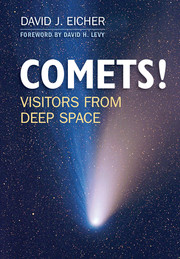Book contents
- Frontmatter
- Dedication
- Contents
- List of Figures
- List of Plates
- Foreword
- Preface
- Acknowledgments
- 1 Strange Lights in the Sky
- 2 Great Comets
- 3 What Are Comets?
- 4 Comets of the Modern Era
- 5 Comets in Human Culture
- 6 Where Comets Live
- 7 The Expanding Science of Comets
- 8 Observing Comets
- 9 Imaging Comets
- Glossary
- Bibliography
- Index
- Plate Section
8 - Observing Comets
Published online by Cambridge University Press: 05 October 2013
- Frontmatter
- Dedication
- Contents
- List of Figures
- List of Plates
- Foreword
- Preface
- Acknowledgments
- 1 Strange Lights in the Sky
- 2 Great Comets
- 3 What Are Comets?
- 4 Comets of the Modern Era
- 5 Comets in Human Culture
- 6 Where Comets Live
- 7 The Expanding Science of Comets
- 8 Observing Comets
- 9 Imaging Comets
- Glossary
- Bibliography
- Index
- Plate Section
Summary
One of history’s great lovers of comets is now remembered for just about anything but comets. French astronomer Charles Messier (1730–1817), who was born in Badonviller, Lorraine, and died in Paris, spent much of his career observing comets at a critical time in the history of observational astronomy. Messier was lured into astronomy by the excitement of seeing the Great Comet of 1744, with its multiple tails, and by observations of an annular eclipse of the Sun in 1748. And it was the return of Halley’s Comet in 1759 that played a critical role in pushing Messier forward into his studies and cataloging of comets and cometlike objects.
In 1750, only about 50 comets were well known since the beginning of time. Keeping track of comets and studying their motions were the critical assignments for anyone interested in the subject. Messier traveled from his hometown to Paris in 1751, seeking his fortune, and was hired by astronomer Joseph-Nicolas Delisle (1688–1768) as a draftsman and recorder of observations. Although Messier first set about copying a map of the Great Wall of China, he was also instructed in the use of astronomical instruments. Messier also took a position as clerk at the Marine Observatory in Paris.
- Type
- Chapter
- Information
- COMETS!Visitors from Deep Space, pp. 154 - 170Publisher: Cambridge University PressPrint publication year: 2013



